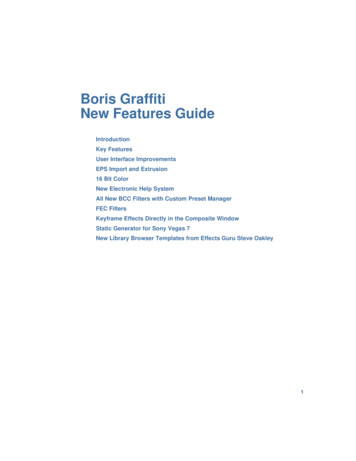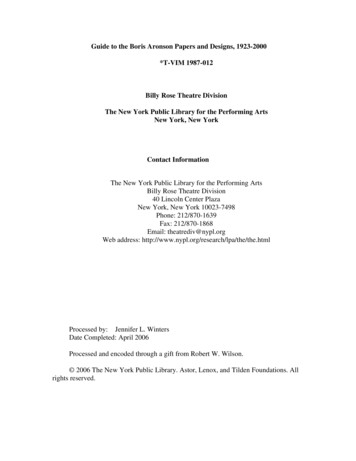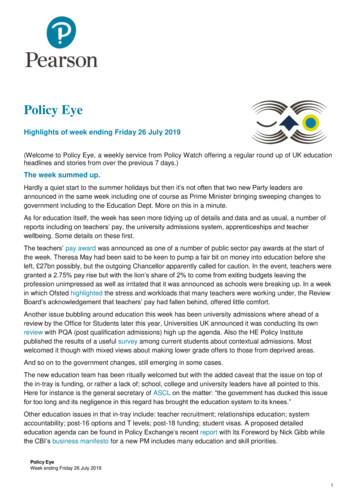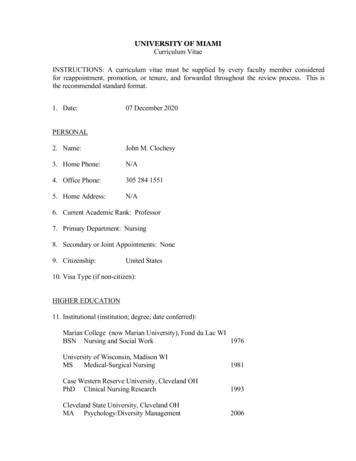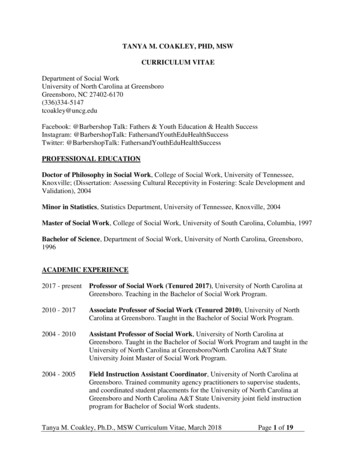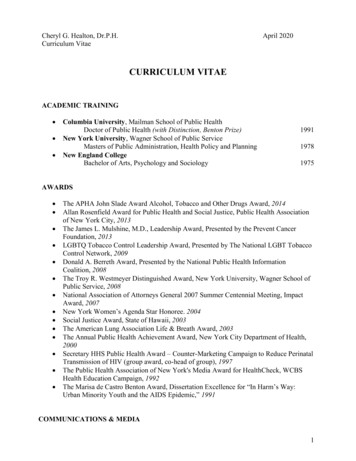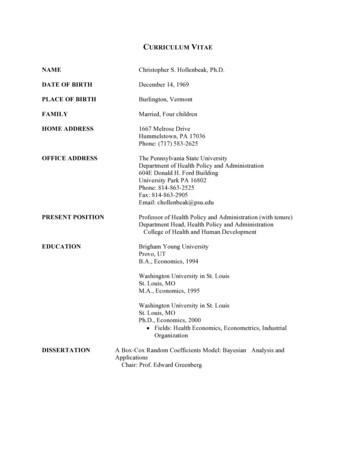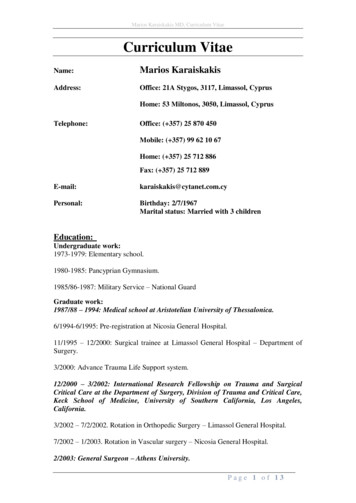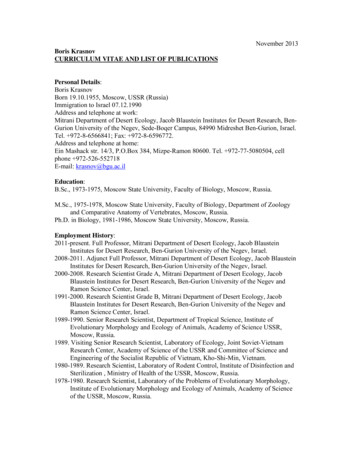
Transcription
November 2013Boris KrasnovCURRICULUM VITAE AND LIST OF PUBLICATIONSPersonal Details:Boris KrasnovBorn 19.10.1955, Moscow, USSR (Russia)Immigration to Israel 07.12.1990Address and telephone at work:Mitrani Department of Desert Ecology, Jacob Blaustein Institutes for Desert Research, BenGurion University of the Negev, Sede-Boqer Campus, 84990 Midreshet Ben-Gurion, Israel.Tel. 972-8-6566841; Fax: 972-8-6596772.Address and telephone at home:Ein Mashack str. 14/3, P.O.Box 384, Mizpe-Ramon 80600. Tel. 972-77-5080504, cellphone 972-526-552718E-mail: krasnov@bgu.ac.ilEducation:B.Sc., 1973-1975, Moscow State University, Faculty of Biology, Moscow, Russia.M.Sc., 1975-1978, Moscow State University, Faculty of Biology, Department of Zoologyand Comparative Anatomy of Vertebrates, Moscow, Russia.Ph.D. in Biology, 1981-1986, Moscow State University, Moscow, Russia.Employment History:2011-present. Full Professor, Mitrani Department of Desert Ecology, Jacob BlausteinInstitutes for Desert Research, Ben-Gurion University of the Negev, Israel.2008-2011. Adjunct Full Professor, Mitrani Department of Desert Ecology, Jacob BlausteinInstitutes for Desert Research, Ben-Gurion University of the Negev, Israel.2000-2008. Research Scientist Grade A, Mitrani Department of Desert Ecology, JacobBlaustein Institutes for Desert Research, Ben-Gurion University of the Negev andRamon Science Center, Israel.1991-2000. Research Scientist Grade B, Mitrani Department of Desert Ecology, JacobBlaustein Institutes for Desert Research, Ben-Gurion University of the Negev andRamon Science Center, Israel.1989-1990. Senior Research Scientist, Department of Tropical Science, Institute ofEvolutionary Morphology and Ecology of Animals, Academy of Science USSR,Moscow, Russia.1989. Visiting Senior Research Scientist, Laboratory of Ecology, Joint Soviet-VietnamResearch Center, Academy of Science of the USSR and Committee of Science andEngineering of the Socialist Republic of Vietnam, Kho-Shi-Min, Vietnam.1980-1989. Research Scientist, Laboratory of Rodent Control, Institute of Disinfection andSterilization , Ministry of Health of the USSR, Moscow, Russia.1978-1980. Research Scientist, Laboratory of the Problems of Evolutionary Morphology,Institute of Evolutionary Morphology and Ecology of Animals, Academy of Scienceof the USSR, Moscow, Russia.
Boris Krasnov2Professional Activities:(a) Positions in academic administration2012-present. Chair, Mitrani Department of Desert Ecology, the Swiss Institute for DrylandEnvironmental and Energy Research, Jacob Blaustein Institutes for Desert Research,Ben-Gurion University of the Negev, Sede-Boqer Campus, Israel.2011-2012. Director, the Swiss Institute for Dryland Environmental and Energy Research,Jacob Blaustein Institutes for Desert Research, Ben-Gurion University of the Negev,Sede-Boqer Campus, Israel.2008-2011. Acting Director, the Swiss Institute for Dryland Environmental and EnergyResearch, Jacob Blaustein Institutes for Desert Research, Ben-Gurion University ofthe Negev, Sede-Boqer Campus, Israel.2000-2007. Director. Ramon Science Center, Jacob Blaustein Institutes for Desert Research,Ben-Gurion University of the Negev, Mizpe-Ramon, Israel.2001-2003. Director, Conservation of Biodiversity in Desert Ecosystems. MASHAVCourse. Blaustein Institute for Desert Research, Ben-Gurion University of the Negevand Ministry of Foreign Affairs of Israel.1989-1990. Coordinator of the ecological researches in tropical rain forests, Joint RussianVietnam Project. Scientific Secretary of Tropical Department. A. N. SevertsovInstitute of Evolutionary Morphology and Ecology of Animals, Russian Academy ofScience, Moscow, Russia.1987-1989. Head of the Expedition of Institute of Disinfection and Sterilization, Ministry ofHealth of the USSR.1981-1986. Deputy Head of the Expedition of Institute of Disinfection and Sterilization,Ministry of Health of the USSR.(b) Professional functions outside universities/institutions2011-present. Member of Editorial Board. Integrative Zoology.2011-present. Associate Editor. Mammalia.2009-present. Committee member. Israeli Taxonomic Initiative.2008-present. Member of Editorial Board. Current Zoology.2008-2011. Member of Editorial Board. The Open Ecology Journal.2007- 2008. Member of Editorial Board. The Open Entomology Journal.2006- present. Subject Editor and Member of Editorial Board. Israel Journal of Ecology andEvolution (former Israel Journal of Zoology)2002- 2010. Member of Editorial Board. Annals of Medical Entomology.2013-2014. Member of Scientific Organizing Committee of 14th International Conference“Rodens & Spatium”, Lisbon, Portugal.2011. Symposium Organizer and Convener (“Mammals and their parasites”). 6th EuropeanMammalogical Congress, Paris, France.2010-2011. Member of Scientific Organizing Committee of 6th European MammalogicalCongress, Paris, France.2008-2009. Member of Scientific Organizing Committee of 10th InternationalMammalogical Congress, Mendoza, Argentina.2007-2008. Member of Scientific Organizing Committee of 11th International Conference“Rodens & Spatium”, Myshkin, Russia.2006-2007. Symposium Organizer and Convener (“Mammals and macroparasites: Are theregeneral rules?). 5th European Mammalogical Congress, Siena, Italy.2006-2007. Member of Scientific Organizing Committee of 10th International Conference“African Small Mammals”, Abomey-Calavi, Benin.
Boris Krasnov32005-2006. Member of Scientific Organizing Committee of 10th International Conference“Rodens & Spatium”, Parma, Italy.2004-2005. Symposium Organizer and Convener (“Macroecology of mammal-parasiterelationships”). 9th International Mammalogical Congress, Sapporo, Japan.2003-2004. Member of Scientific Organizing Committee of 9th International Conference“Rodens & Spatium”, Lublin, Poland.2002-2003. Member of Scientific Organizing Committee of 9th International Conference“African Small Mammals”, Morogoro, Tanzania.2002-2003. Member of Scientific Organizing Committee of 4th European Congress ofMammalogy, Brno, Czech Republic.2001-2002. Member of Scientific Organizing Committee of 8th International Conference“Rodens & Spatium”, Louvain-la-Neuve, Belgium.1988. Member of the Organizing Committee of the 7th National Conference on Rodents,Nalchik, USSR.1988. Member of the Organizing Committee of National Conference on House Mouse,Nalchik, USSR.1987-1990. Member of the Committee of House Mouse of Russian Academy of Science.(c) Significant professional consulting1999-2005. Expert. INTAS Association (European Union). Review of research proposals.Reviewer of manuscripts for Mammalia, Environmental Entomology, Israel Journal ofZoology, Diversity and Distributions, Animal Behaviour, Elytron, Journal ofMedical Entomology, Canadian Journal of Zoology, Ecography, Oikos, Ecology,Behavioral Ecology and Sociobiology, Physiological and Biochemical Zoology,Belgian Journal of Zoology, Acta Parasitologica, Parasitology, Journal ofParasitology, Acta Theriologica, Functional Ecology, Journal of Animal Ecology,Ecological Entomology, Global Ecology and Biogeography, Acta Zoological Sinica,Ecological Research, Australian Journal of Zoology, Acta Ethologica, Journal ofTropical Ecology, International Journal for Parasitology, Oecologia, Revista de laSociedad Entomológica Argentina, Biological Letters of the Royal Society ofLondon, Biological Journal of the Linnean Society, Australian Journal of Zoology,Comparative Parasitology, Journal of Biogeography, Integrative Biology,Behavioral Ecology, Bioessays, Journal of Insect Sciences, Journal of PhysicalAntropology, Behavioral Ecology, Current Zoology, Israel Journal of Ecology andEvolution, Vector-Borne and Zoonotic Diseases, Journal of Mammalogy, IntegrativeZoology, African Journal of Zoology.Reviewer of research proposals for US-Israel Binational Science Foundation, US-IsraelBinational Agricultural Research and Development Fund, Academy of Sciences ofCzech Republic, National Science Foundation (USA), Research Foundation –Flanders (Belgium), Israel Science Foundation, French National Research Agency,National Commission for Scientific and Technological Research (CONICYT) ofChile.Reviewer of reports for World Health Organization.2006-2007. Organization of departmental seminars. Mitrani Department of Desert Ecology,Jacob Blaustein Institutes for Desert Research, Ben-Gurion University of the Negev.(f) Membership in professional/ scientific societies2011-present. Society for Integrative and Comparative Biology.2010-present. International Biogeography Society.
Boris Krasnov42009-present. Entomological Society of Israel.1999-2006. Society of Vector Ecology.1999-present. Ecological Society of America.1992-present. Zoological Society of Israel.1995-2005t. Animal Behavior Society.1978-present. Russian Mammalogical Society.1978-1990. Moscow Society of Naturalists.1980-1989. Russian Disinfectionist Society.Educational activities(a) Courses taught1. Guided Reading in Macroecology. Graduate. Albert Katz International School for desertStudies. 2005 and 2007.2. Guided Reading in Evolutionary Ecology of Parasitism. Graduate. Albert KatzInternational School for Desert Studies. 2004-2005 and 2012-present.3. Evolutionary Ecology of Parasitism. Graduate. Albert Katz International School fordesert Studies and Department of Life Science, Ben-Gurion University of the Negev,Israel. 2003 - present4. Introduction to Dryland Ecology. Graduate. Albert Katz International School for DesertStudies, Blaustein Institute for Desert Research, Ben-Gurion University of the Negev,Israel (jointly). 2000-2002.5. Mammalian Taxonomy, Ecology and Evolution. Undergraduate. Department of LifeScience, Ben-Gurion University of the Negev, Israel. 1997-present6. Conservation of Biodiversity in Desert Ecosystems. MASHAV Course. BlausteinInstitute for Desert Research, Ben-Gurion University of the Negev and Ministry ofForeign Affairs of Israel (jointly). 1998-2003.(b) Research students.Trainees and project students.2009. Corinna Kiefer, University of Karlsruhe and Ben-Gurion University.2009. Alexandra Plotzker, University of Karlsruhe and Ben-Gurion University.2006-2007. Eayl Bloche (jointly with Z. Abramsky and A. Bouskila, Department of LifeScience, Ben-Gurion University), Ben-Gurion University.2005. Dikla Bashary (jointly with Z. Abramsky, Department of Life Science, Ben-GurionUniversity), Ben-Gurion University.2003. Lusine Ghazaryan (Armenia), trainee, Ben-Gurion University.2003. Tatiana Ulianova (Russia), trainee, Ben-Gurion University.2002. Marine Arakelyan (Armenia), trainee, Ben-Gurion University.2001. Izik Oguzoglu (Turkey), trainee, Ben-Gurion University.2000. Megan McMaster (South Africa), trainee, Ben-Gurion University.2000. Tatyana Demidova (Russia), trainee, Ben-Gurion University.1998. Luis Rios Gonsales (Guatemala), trainee, Ben-Gurion Unversity.1998. Maria Lizurume (Argentina), trainee, Ben-Gurion University.M.Sc. students2010-2011. Victoria Liberman (Albert Katz International School for Desert Studies, BenGurion University)2009-2010. Ashkhen Karapetyan (jointly with A. Degen, Albert Katz International Schoolfor Desert Studies, Ben-Gurion University).
Boris Krasnov52009-2010. Ruzanna Gevorgyan (jointly with A. Degen, Albert Katz International Schoolfor Desert Studies, Ben-Gurion University).2009-2011. Shai Pilosof (jointly with C. Korine, Albert Katz International School for DesertStudies, Ben-Gurion University).2008-2010. Adi Arbiv (jointly with O. Ovadia, Department of Life Science, Ben-GurionUniversity).2008-2010. Khorean Avetysyan (jointly with A. Degen, Albert Katz International Schoolfor Desert Studies, Ben-Gurion University).2007-2008. Voldu Araya (Albert Katz International School for Desert Studies, Ben-GurionUniversity).2007-2009. Vahan Serobyan (jointly with A. Degen, Albert Katz International School forDesert Studies, Ben-Gurion University).2006-2009. Ashael Raveh (jointly with Z. Abramsky, Department of Life Science, and BurtKotler, Mitrani Department of Desert Ecology, Ben-Gurion University).2006-2008. Lusine Khondkaryan (jointly with G. Shenbrot, Albert Katz InternationalSchool for Desert Studies, Ben-Gurion University).2004-2005. Dikla Bashary (jointly with Z. Abramsky, Department of Life Science, BenGurion University).2004-2006. Ana Hovhanyan (jointly with A. Degen, Albert Katz International School forDesert Studies, Ben-Gurion University).2004-2006. Lusine Ghazaryan (jointly with A. Degen, Albert Katz International School forDesert Studies, Ben-Gurion University).2003-2005. Andrey Bogdanov (jointly with A. Degen, Albert Katz International School forDesert Studies, Ben-Gurion University).2002-2004. Natella Mirzoyan (jointly with A. Degen, Albert Katz International School forDesert Studies, Ben-Gurion University).2002-2004. Mariela Leiderman (jointly with Y. Lubin, Albert Katz International School forDesert Studies, Ben-Gurion University).2001-2003. Michal Sarfati (jointly with A. Degen, Albert Katz International School forDesert Studies, Ben-Gurion University).2001-2003. Hadas Hawlena (jointly with Z. Abramsky, Department of Life Science, BenGurion University).1987-1988. Nadezhda Derviz (jointly with S. Shilova, Kalinin State University, Russia).1985-1986. Helena Kudriavtseva (jointly with S. Shilova, Novosibisrk State University,Russia).Ph.D. students2011-present. Shai Pilosof (Albert Katz International School for Desert Studies, Ben-GurionUniversity).2009-present. Ashael Raveh (jointly with Z. Abramsky, Department of Life Science, andBurt Kotler, Mitrani Department of Desert Ecology, Ben-Gurion University).2003-2006. Hadas Hawlena (jointly with Z. Abramsky, Department of Life Science, BenGurion University).1998-2000. Pirchia Sinai (jointly with I. Choshniak, Tel-Aviv University).(c) Post-doctorate fellows.2009. Dr. Uri Gordon (jointly with U. Safriel, Jacob Blaustein Institutes for DesertResearch, Ben-Gurion University of the Negev).
Boris Krasnov62005-2006. Dr. Hadas Hawlena (jointly with Z. Abramsky, Department of Life Science,Ben-Gurion University).2004-2005. Dr. Joelle Gouy de Bellocq (France) (jointly with B. Pinshow, Jacob BlausteinInstitutes for Desert Research, Ben-Gurion University of the Negev).2013-2014. Dr. Elizabeth Dlugosz (USA).Awards2003. Poula and David Ben-Gurion Foundation. Yudith and Abraham Pasternak Prize.2006. BGU Rector’s Award for Outstanding Scientists.2010. The Minister of Immigrant Absorption's Prize for Outstanding Scientists.Scientific publications(a) Authored books1. Shenbrot, G.I., Krasnov, B.R. & Rogovin, K.A. 1999. Spatial Ecology of Desert RodentCommunities. SpringerVerlag, Berlin-Heidelberg-New York, 292 p.Reviewed by D. Kelt (2000). Journal of Mammalogy 81: 1177-1179.Reviewed by F. Kay (2000). Journal of Arid Environments 44: 263-264.Reviewed by M. Daly (2001). Ethology 107: 666.2. Shenbrot, G.I. & Krasnov, B. R. 2005. An Atlas of the Geographic Distribution of theArvicoline Rodents of the World (Rodentia, Muridae: Arvicolinae). Pensoft Publ.,Sofia.3. Krasnov, B. R. 2008. Functional and Evolutionary Ecology of Fleas: A Model forEcological Parasitology. Cambridge University Press.Reviewed by K. Dittmar (2009). Quarterly Review of Biology 84: 113-114.Reviewed by M. Hastriter (2009). Journal of Medical Entomology 46: 716-716.Reviewed by P. Moore (2009). Bulletin of the British Ecological Society 40: 52.Reviewed by B. Dixon (2009). Bookshelf 56: 100.(b) Editorship of collective volumes1. Sokolov, V. E., Kotenkova, E. V. & Krasnov, B. R. 1989. Домовая Мышь (The HouseMouse), Nauka, Moscow (in Russian).2. Krasnov, B. R. & Mazor, E. (eds). 2001. The Makhteshim Country: Laboratory of Nature,Pensoft Publ., Sofia.3. Morand, S., Krasnov, B. R. & Poulin, R. (eds). 2006. Micromammals andMacroparasites: From Evolutionary Ecology to Pest Management. SpringerVerlag,Tokyo Berlin Heidelberg New York.Reviewed by J. Light (2009). Journal of Mammalian Evolution 16: 53-55.4. Morand, S. & Krasnov, B.R. 2010. The Biogeography of Host-Parasite Interactions.Oxford University Press, Oxford.Reviewed by J.-F. Guegan (2011). Parasites and Vectors 4: 34.Reviewed by D. Simberloff (2001). Bioscience 61: 925-927.5. Morand, S., Krasnov, B.R. & Littlewood, T. 2014. Parasite Diversity and Diversification:Evolutionary Ecology Meets Phylogenetics. Cambridge University Press(forthcoming)(c) Chapters in collective volumes1. Vorob’ova, E. I. & Krasnov, B. R. 1979. Морфо-функциональный анализ зубнойсистемы ящериц (Morpho-functional analysis of the tooth system in lizards). In:Vorob’ova, E., Iordansky, N. (eds.). Состояние и перспективы развития
Boris Krasnov7морфологии.(Current State and Perspectives of Morphology), Nauka, Moscow,Russia, pp. 122-127.2. Krasnov, B. R., Khokhlova, I. S. & Stefanov, V. 1981. Использование бродифакумадля одновременного контроля численности нескольких видов грызунов (Use ofBrodyfacum for simultaneous control of several rodent species). In: Lyarsky, P.P.(ed.). Современные проблемы медицинской дезинфекции и стерилизации(Modern Problems of Medical Disinfection and Sterilization), All-Union Institute ofDisinfection and Sterilization, Moscow, pp. 75-76 (in Russian).3. Shilova, S. A., Stchipanov, N. A. & Krasnov, B. R. 1982. Контроль численностигрызунов в стогах (Rodent control in the cornricks). In: Lyarsky, P.P. & Dryomova,V.P. (eds.). Научные основы дезинфекции и стерилизации (Scientific Basis ofDisinfection and Sterilization), All-Union Institute of Disinfection and Sterilization,Moscow, pp. 86-88 (in Russian).4. Shilova, S. A., Krasnov, B. R., Nabenov, K. & Kudryavtzeva, E. 1983. Использованиенового пестицида бродифакума для контроля численности домовых мышей (Useof the new pesticide, Brodyfacum, for the house mouse control). In: Lyarsky, P.P,Dryomova, V.P. & Shilova, S.A. (eds.). Теория и практика дезинфекции истерилизации (Theory and Practice of Disinfection and Sterilization), All-UnionInstitute of Disinfection and Sterilization, Moscow, pp. 90-96 (in Russian).5. Krasnov, B. R. & Knyazeva, T. V. 1983. Обмен эктопаразитами между полуденнойпесчанкой Meriones meridianus и домовой мышью Mus musculus в эксперименте(Ectoparasite exchange between the midday jird, Meriones meridianus, and the housemouse, Mus musculus, under experiment). In: Taran, I.F. (ed). вых заболеваний (Prophylaxis of Diseases in the Natural Foci),Plague-Control Institute of Caucasus and Trans-Caucasus, Stavropol, pp. 243-244 (inRussian).6. Krasnov, B. R. & Krasnova, I. S. 1984. Изменения видового состава сообществмелких млекопитающих в сельском населенном пункте после проведения работпо контролю численности (Changes in species composition of small mammalcommunity in rural settlement after control activities). In: Turov, I. S. (ed.).Актуальные проблемы дезинфекции и стерилизации (Actual Problems ofDisinfection and Sterilization), All-Union Institute of Disinfection and Sterilization,Moscow, pp. 111-114 (in Russian).7. Stchipanov, N. I., Orlenev, D. P., Kasatkin, M. V., Oleinichenko, V. Y. & Krasnov, B. R.1989. Мелкие млекопитающие в сельскохозяйственном ландшафте предгорийДагестана (Small mammals in the agricultural landscape of the Dagestan foothills).In: Khokhlov, A. N., Savelieva, V. V. (eds.). Экологические проблемыСтавропольского региона (Ecological Problems of the Stavropol Region), StavropolCommittee of Nature Protection Society, Stavropol, pp. 335-357 (in Russian).8. Krasnov, B. R. & Khokhlova, I. S. 1989. Лабильность кой структуры группировок домовой мыши как стратегия адаптациик условиям среды (Plasticity of spatial and social structure of the house mousepopulations as a strategy of adaptations to changing environment). In: Sokolov, V. E.,Kotenkova, E. V. & Krasnov, B. R. (eds.). Домовая мышь (The House Mouse),Nauka, Moscow, pp. 223-253 (in Russian, English summary).9. Smirnova, T. V., Krasnov, B. R., Shalilova, V. & Ivanitzkaya, E. Y. 1989. Новыйпестицид этилфенацин для контроля домовой мыши (New pesticide ethylphenacin - for control of the house mouse). In: Sokolov, V. E., Kotenkova, E. V.
Boris Krasnov8& Krasnov, B. R. (eds.). Домовая мышь (The House Mouse), Nauka, Moscow, pp.346-349 (in Russian, English summary).10. Krasnov, B. R. & Khokhlova, I. S. 1994. Пространственная структура популяций.(Spatial structure of populations) . In: Kotenkova, E. V. & Bulatova, N. (eds.).Домовая мышь. Систематика, биология, распространение. (The House Mouse(Mus musculus). Taxonomy, biology, distribution), Nauka, Moscow, pp. 190-215 (inRussian, English summary).11. Shilova, S. A., Krasnov, B. R. & Stchipanov, N. A. 1991. Прикладной аспектпопуляционной экологии (на примере мелких млекопитающих) (The applicationaspect of population ecology (small mammals as a model)). In: Shilov, I. A. (ed.).Экология популяций (Ecology of Populations). Moscow, Nauka, pp. 35-53 (inRussian, English summary).12. Shenbrot, G. I. & Krasnov, B. R. 1996. Patterns of animal distribution along the rainfallgradient in the Central Negev as an indicator of Global Climate Changes. In:Steinberger, Y. (ed.). Preservation of our world in the wake of change. Proceedings ofthe Sixth International Conference of Israeli Society for Ecology and EnvironmentalQuality Sciences. vol. VI. ISEEQS Publ., Jerusalem, pp.185-186.13. Shenbrot, G. I. & Krasnov, B. R. 2001. Geographic variation in the role of gerbils andjirds (Gerbillinae) in rodent communities across the Great Palaearctic Desert Belt. In:Denys, C., Granjon, L. & Poulet, A. (eds.). African Small Mammals, IRD Editions,Paris, pp. 511-529.14. Shenbrot, G. I. & Krasnov, B. R. 2001. Rodents in desert environment: Is densitydynamics really correlated with annual rainfall fluctuations? In: Prakash, I. (ed.).Ecology of Desert Environments. Festschrift for Professor J.L.Cloudsley-Thompson.Scientific Publishers, Jodhpur, pp. 405-421.15. Krasnov, B. R. & Shenbrot, G. I. 2001. Tenebrionid beetles of Makhtesh Ramon:diversity, seasonality and community structure. In: Krasnov, B. R. & Mazor, E. (eds.).The Makhteshim Country: Laboratory of Nature, Pensoft Publ., Sofia, pp. 187-216.16. Krasnov, B. R., Khokhlova, I. S., Burdelova, N. V. & Shenbrot, G. I. 2001. Fleaassemblages on rodents in Makhtesh Ramon: host-habitat mediation of host-parasiterelationships. In: Krasnov, B. R. & Mazor, E. (eds.). The Makhteshim Country:Laboratory of Nature, Pensoft Publ., Sofia, pp. 251-272.17. Krasnov, B. R. 2001. A monitoring protocol for a nature reserve: The case study for theRamon Park Nature Reserve. In: Krasnov, B. R. & Mazor, E. (eds.). The MakhteshimCountry: Laboratory of Nature, Pensoft Publ., Sofia, pp. 309-322.18. Krasnov, B. R., Mazor, E., Avni, Y., Plakht, J. R. & Shenbrot, G. I. 2001. Urbanecology: Mizpe Ramon as and example. In: Krasnov, B. R. & Mazor, E. (eds.). TheMakhteshim Country: Laboratory of Nature, Pensoft Publ., Sofia, pp. 365-384.19. Shenbrot, G. I. & Krasnov, B. R. 2001. Rodents of Makhtesh Ramon: habitatdistribution and temporal dynamics of spatial organization of communities. In:Krasnov, B. R. & Mazor, E. (eds.). The Makhteshim Country: Laboratory of Nature,Pensoft Publ., Sofia, pp. 235-250.20. Shenbrot, G. I. & Krasnov, B. R. 2001. Lizards of Makhtesh Ramon: habitat distributionand spatial organization of communities. In: Krasnov, B. R. & Mazor, E. (eds.). TheMakhteshim Country: Laboratory of Nature, Pensoft Publ., Sofia, pp. 217-234.21. Mazor, E. & Krasnov, B. R. 2001. Makhteshim Country, Ramon Science Center andNature Laboratory. In: Krasnov, B. R. & Mazor, E. (eds.). The Makhteshim Country:Laboratory of Nature, Pensoft Publ., Sofia, pp. 1-32.
Boris Krasnov922. Mazor, E. & Krasnov, B. R. 2001. Vivid research in the Laboratory of Nature. In:Krasnov, B. R. & Mazor, E. (eds.). The Makhteshim Country: Laboratory of Nature,Pensoft Publ., Sofia, pp. 403-404.23. Morand, S., Poulin, R. & Krasnov, B. R. 2006. Global changes and the future ofmammal-macroparasite interactions. In: Morand, S., Krasnov, B.R. & Poulin, R.(eds.). Micromammals and macroparasites: From evolutionary ecology tomanagement. SpringerVerlag, Tokyo Berlin Heidelberg New York, pp. 617-636.24. Medvedev, S. & Krasnov, B.R. 2006. Fleas - permanent satellites of small mammals. In:Morand, S., Krasnov, B.R. & Poulin, R. (eds.). Micromammals and macroparasites:From evolutionary ecology to management. SpringerVerlag, Tokyo Berlin HeidelbergNew York, pp. 161-278.25. Poulin, R., Krasnov, B.R. & Morand, S. 2006. Patterns of host specificity in parasitesexploiting small mammals. In: Morand, S., Krasnov, B.R. & Poulin, R. (eds.).Micromammals and macroparasites: From evolutionary ecology to management.SpringerVerlag, Tokyo Berlin Heidelberg New York, pp. 233-256.26. Krasnov, B. R., Morand, S. & Poulin, R. 2006. Patterns of macroparasite diversity insmall mammals. In: Morand, S., Krasnov, B.R. & Poulin, R. (eds.). Micromammalsand macroparasites: From evolutionary ecology to management. SpringerVerlag,Tokyo Berlin Heidelberg New York, pp. 197-232.27. Morand, S., Krasnov, B. R., Poulin, R. & Degen, A. A. 2006. Micromammals andmacroparasites: Who is who and how do they interact? In: Morand, S., Krasnov, B.R.& Poulin, R. (eds.). Micromammals and macroparasites: From evolutionary ecologyto management. SpringerVerlag, Tokyo Berlin Heidelberg New York, pp. 3-12.28. Krasnov, B.R. 2009. Ectoparasite population denamics: Determinants of ectoparasitespecies composition. In: Hare, P.A. (ed.). Transfer of Technology: Sustainable andUnsustainable Experience from Israel. BiblioBooks, Florida, pp. 257-271.29. Morand, S. and Krasnov, B.R. 2010. Introduction. In: Morand, S. and Krasnov, B.R.(eds.). The biogeography of host-parasite interactions. Oxford University Press,Oxford, pp. 1-4.30. Bordes, F., Morand, S., Krasnov, B.R. and Poulin, R. 2010. Parasite diversity andlatitudinal gradients in terrestrial mammals. In: Morand, S. and Krasnov, B.R. (eds.).The biogeography of host-parasite interactions. Oxford University Press, Oxford, pp.89-98.31. Krasnov, B.R. and Poulin, R. 2010. Ecological properties of a parasite: species-specificstability and geographical variation. In: Morand, S. and Krasnov, B.R. (eds.). Thebiogeography of host-parasite interactions. Oxford University Press, Oxford, pp. 99114.32. Poulin, R. and Krasnov, B.R. 2010. Similarity and variability in parasite assemblagesacross geographical space. In: Morand, S. and Krasnov, B.R. (eds.). The biogeographyof host-parasite interactions. Oxford University Press, Oxford, pp. 115-128.33. Morand, S., Bordes, F., Pisanu, B., Goüy de Bellocq, J. and Krasnov, B.R. 2010. Thegeography of defence. In: Morand, S. and Krasnov, B.R. (eds.). The biogeography ofhost-parasite interactions. Oxford University Press, Oxford, pp. 159-172.34. Morand, S. and Krasnov, B.R. 2010. Conclusions and Perspectives. In: Morand, S. andKrasnov, B.R. (eds.). The biogeography of host-parasite interactions. OxfordUniversity Press, Oxford, pp. 267-270.35. Krasnov, B.R. 2013. Ectoparasites of small mammals: interactive saturated andunsaturated communities. In: K. Rohde (ed.). The Balance of Nature and HumanImpact. Cambridge University Press, Cambridge, pp. 89-102.
Boris Krasnov1036. Krasnov, B.R. & Rizzoli, A. 2013. Population dynamics of ectoparasites of terrestrialhosts. In: K. Rohde (ed.). The Balance of Nature and Human Impact. CambridgeUniversity Press, Cambridge, pp. 21-34.(d) Refereed articles in scientific journals (h-index 28)1. Krylova, T. V. & Krasnov, B. R. 1980. Влияние стерилянта из группы этилениминовна репродуктивный цикл и поведение обыкновенной полевки Mus musculus (Theeffect of ethylenimin sterilant on reproductive cycle and behavior of the common vole(Microtus subarvalis)). Biological Sciences 7: 46-54 (in Russian, English summary).2. Krasnov, B. R. 1984. Совместное обитание полуденных песчанок Merionesmeridianus и домовых мышей Mus musculus в полупустыне Северо-ЗападногоПрикаспия (Co-habitation of the midday jird (Meriones meridianus) and the housemouse (Mus musculus) in the northwestern Caspian lowlands). Zoologichekyi Zhurnal63: 421-428 (in Russian, English summary).3. Khokhlova, I. S. & Krasnov, B. R. 1986. Механизмы авторегуляции плотности впопуляциях домовой мыши (Mus musculus с различными типамипространственной структуры (Mechanisms of density autoregulation in the housemouse (Mus musculus) populations with different types of spatial structure).Zoologichekyi Zhurnal 65: 407-415 (in Russian, English summary).4. Krasnov, B. R. & Khokhlova, I. S. 1988. Взаимоотношения синантропных и дикихгрызунов в сельских населенных пунктах и последствия мероприятий поконтролю численности (Interactions between synanthropic and non-synanthropicrodents in rural settlements and the consequences of rodent control). ZoologichekyiZhurnal 67: 600-609 (in Russian, English summary).5. Krasnov, B. R. 1988. Экология домовой мыши Mus musculus L. (Rodentia: Muridae)крайнего северо-востока палеарктики (Ecology of the house mouse, Mus musculusL. (Rodentia: Muridae) in the extreme North-East of the Palaearctic). ZoologichekyiZhurnal 67: 102-110 (in Russian, English summary).6. Krasnov, B. R. 1988. Особенности биологии домовой мыши (Biology of the housemouse). Chemistry and Life 12: 56-68 (in Russian).7. Krasnov, B. R., Shilova, S. A. & Smirin, Y. M. 1990. Домовая мышь как факторпрепятствующий заселению сельских населенных пунктов другими видамигрызунов (The house mouse as a factor preventing rural settlement occupation byother rodent species). Bulletin of the Moscow Naturalist Society, Ser. Biol. 95: 30-37(in Russian, English summary).8. Khokhlova, I. S., Krasnov, B. R., Shenbrot, G. I. & Degen, A. A. 1994. Характерсезонных изменений массы тела у некоторых видов грызунов кратера Рамон,пустыня Негев, Израиль (Seasonal body mass changes and habitat distribution inseveral rodent species from the Ramon erosion cirque, Negev Highlands, Israel).Zoologichekyi Zhurnal 73: 115-121 (in Russian, English summary).9. Shenbrot, G. I., Krasnov, B. R. & Khokhlova I. S. 1994. On the biology of Gerbillushenleyi (Rodentia: Ge
Boris Krasnov 6 2005-2006. Dr. Hadas Hawlena (jointly with Z. Abramsky, Department of Life Science, Ben-Gurion University). 2004-2005. Dr. Joelle Gouy de Bellocq (France) (jointly with B. Pinshow, Jacob Blaustein Institutes for Desert Research, Ben-Gurion University of the Negev). 2013-2014. Dr. Elizabeth Dlugosz (USA). Awards
